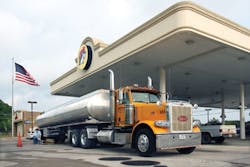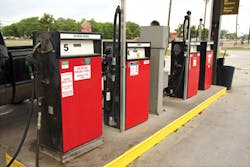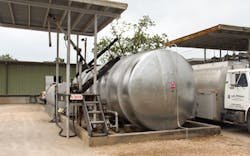RB Stewart
A SOUTHEAST Texas phenomenon, Buc-ees' 30-plus c-stores and travel centers draw crowds of enthusiastic motorists with some of the best restrooms in the industry and great food. While customers cite the amenities as a big reason for choosing Buc-ees, they buy a lot of fuel on each visit.
Responsibility for keeping the Buc-ees locations well supplied with gasoline and diesel falls on RB Stewart Petroleum Products Inc in Angleton, Texas. With its 11-transport fleet, the petroleum marketer and hauler moves most of the fuel sold through the Buc-ees stores.
“We are the house trucking company for Buc-ees and have been since 1998,” says Pete Petrosky Jr, RB Stewart owner. “Buc-ees accounts for the overwhelming majority of the 100-million-plus gallons of refined fuels we haul annually. We handle most of the fuel shipments with our own fleet, but we also work with three common carriers that supply Buc-ees stores beyond our regular operating area.
Jobber history
RB Stewart got its start more than 30 years ago as a Texaco jobber, and it continues to handle branded some branded product. “We're no longer a Texaco marketer, but we distribute for Phillips 66, Valero, Citgo, shell, Chevron, and Exxon,” Petrosky says. “However, unbranded product now accounts for a higher percent of the fuel we transport.”
The company still operates out of the bulk plant that housed operations for much of the company's history. Today, facility serves as a maintenance shop and cardlock fueling station. Regular and premium unleaded gasoline are stored underground in 18,000-gallon tanks, and diesel blended with 10% biodiesel is stored aboveground in a 22,000-gallon tank.
Early on, farming made up most of RB Stewart's customer base, but those days are long past. “Agriculture was big in this area (south of Houston and not far from the Gulf Coast), but many of the farms are gone now,” Petrosky says. “C-store deliveries make up 90% of our business today.”
Common carriers met most of RB Stewart's fuel transport needs for many years, including deliveries to service stations. A small fleet of tankwagons operating out of the company's small bulk plant took care of deliveries to farms and commercial accounts.
As the Buc-ees business took off, Petrosky and his managers realized that they needed more control over the c-store deliveries. It was time for RB Stewart to begin building its own petroleum transport fleet. The first of the petroleum marketer's 11 tractor-trailer rigs hit the road in 2002.
“As Buc-ees opened high-volume stores, we had to make sure that those locations were supplied without any interruption,” Petrosky says. “We simply couldn't run the risk of those stores running out of fuel. We also needed more flexibility and control over routing and dispatch activities.”
High-tech systems
Fuel monitoring and fleet dispatch activities have become high-tech operations at RB Stewart. Management systems include the TelaPoint fuel monitoring application from Wright Express and the Teletrac truck monitoring and tracking system. Both products are web based.
TelaPoint gives RB Stewart the ability to remotely manage fuel inventories for each one of the Buc-ees c-stores. “This is a very good product that gives us great control over our fuel distribution process,” says James Somes, RB Stewart lead dispatcher. “It interfaces with the storage tank monitors at the c-stores, enabling us to check fuel inventories hourly. That is critical for the high-volumes stores that get multiple deliveries every day.”
On the truck side, dispatchers have gained greater control over the fleet operation with Teletrac, which combines GPS-based vehicle tracking with onboard systems monitoring. The system provides real-time updates on vehicle location, engine performance, idling and fuel consumption, and other key data. Additionally, the onboard system has a theft-prevention component.
The technology helps dispatchers and drivers maximize productivity across an operating area with a 150-mile radius. With Buc-ees expanding into new markets, that operating radius is being stretched, and RB Stewart is looking at the possibility of adding its first satellite location.
Traffic congestion
While most deliveries are outside the Houston city limits, Houston traffic congestion does impact RB Stewart's operations. “Most of the loading racks we pull from are in the Pasadena and Deer Park (Houston suburbs) areas, and a majority of our deliveries are within 50 miles of the racks,” Somes says. “We try to limit the impact of traffic congestion as much as possible to make sure drivers average three loads per shift. That's about the best we can do in this area, because loading takes about half an hour at the rack and each trip is at least an hour to and from the rack.”
Maximizing productivity means slipseating every one of the 11 tractors in the fleet. “Every time we add a tractor to the fleet, we hire two drivers. Our trucks are running just about around the clock. Maintenance is the only scheduled downtime.”
Drivers work 12-hour shifts with start times at 4 am and 4 pm. “We picked those times because our drivers can usually beat the crowds at the racks when they go to pick up the first load of their shift,” Petrosky says. “They are also able to avoid some of the Houston traffic.”
Shifts start and end at the RB Stewart bulk plant and terminal in Angleton, which is about 51 miles from the nearest petroleum terminal in Pasadena. Drivers have no assigned routes. They haul fuel to any of the RB Stewart customer locations.
It is a demanding job, but the company has minimal turnover and little trouble attracting applicants when driving positions do open up. Minimum qualifications call for age 25, three years of tank transport driving experience, and a Transportation Worker Identification Credential (TWIC).
The big question for the fleet is this: Is it better to hire a tanker driver with no fuel hauling experience, or is the driver with fuel experience the better choice? “On the one hand, we can avoid bad habits by hiring drivers with no fuel delivery experience,” says John Cantu, JMCC Consulting and contract safety manager at RB Stewart. “We can train the driver to do the job our way. On the other hand, a driver with fuel experience usually needs less training and may already have all of the fuel rack certification cards for the Houston area.”
Much of the new-hire training is handled by Cantu and Randy Gros, RB Stewart senior driver and trainer. Even though the company hires only experienced truck drivers, training can still take up to a month. New hires get a good overview of the operation, including the fleet equipment.
RB Stewart runs primarily Peterbilt longnose daycab tractors, and the newest units are Model 388s. “When we decided to set up our fuel transport fleet, I talked with some friends who had heavy-haul operation,” Petrosky says. “They recommended Peterbilt as the best choice, and we've been with Rush Peterbilt in Houston ever since. They provide great service, which means a lot to us.”
The newest tractor in the fleet has a Cummins ISX engine rated at 475 horsepower, but the company chose Caterpillar C15 engines in the past. For transmissions, the company chooses 13-speed Eaton Fuller units. “We prefer manual transmissions, because we can maintain them in-house, and our drivers like them,” Petrosky says.
RB Stewart is a strong believer in biodiesel fuel blends, and it runs B10 in its own fleet. “We support biodiesel as an alternative fuel,” Petrosky says. “While we haven't seen any improvement in fuel economy beyond what we were already getting with ULSD (ultra low sulfur diesel), we do get a tax break in Texas. We purchase only injection-blended biodiesel from the Kinder Morgan terminal in Pasadena, one of just two in the Houston area that has injection blending. We're just more comfortable with injection blended biodiesel.”
The daycab tractors are built for hard work, but they also provide ample driver comfort. Rubber floor mats make it easy to keep the interior clean, and the cabs are well insulated to control road noise. Driver features include a stereo radio and a Cobra CB radio.
Aluminum disc wheels are standard for the fleet. Dunlop and Goodyear tires are supplied through a national account with Snider Tire Inc.
All 11 petroleum trailers in the fleet are from Polar Tank Trailer LLC. “We started buying Polar trailers because we had a local connection,” Petrosky says. “Polar builds great equipment, and we've stayed with their trailers because we believe vehicle standardization is important in a slip-seat operation.”
The DOT406 trailers have a 9,300-gallon capacity and can haul 9,000 gallons of gasoline under special permit on Texas state highways. Double walls separate each of the five compartments on the straight-barrel tankers. Hardware includes Civacon and Scully overfill protection and Civacon bottom-loading valves. All of the trailers have Hendrickson's Intraax air suspension system.
Maintenance program
In-house maintenance is a critical factor in the RB Stewart operation. “When you are trying to keep a petroleum fleet running virtually around the clock, you must watch the equipment very closely,” says Alan Petrosky, RB Stewart mechanic. “Unplanned downtime is a major issue because shipments are missed and stores can run out of fuel.”
Tractors and trailers run 10,000 to 12,000 miles per month in the RB Stewart operation and are on a 15,000-mile preventive maintenance schedule. Each PM includes a change of engine oil and filter, chassis lube, and thorough inspection. Fuel filters are changed at every other PM interval.
Tractor warranty work is sent to Rush Peterbilt, and Caterpillar engine repairs are sent to the Houston Cat dealer. Department of Transportation-mandated tank tests and inspections are handled by Cothern's Tanker Inspection in Somerville, Texas.
“Tractors now contain such complex technology that we have to use the experts at Peterbilt and Caterpillar to make sure trucks and engines are properly maintained and repaired,” Alan Petrosky says. “We use Cothern's for tank tests and inspections because they come to our terminal and work on three or four trailers at a time.
“We still do plenty of our own repair work, though. We repair radiators, turbochargers, and air-conditioning on the tractors. We service loading probes and the vapor recovery system on the trailers. We inspect the kingpin and upper coupler plate on our trailers. We do some tire and wheel work, including balancing.”
A key objective of the in-house maintenance program is to keep the fleet looking and running like new. For instance, control pedals and floor mats are replaced when they begin to look worn. Any damage is repaired as quickly as possible. Tractors and trailers usually are washed weekly at Blue Beacon Truck Washes.
Fleet appearance is part of the overall effort at RB Stewart to provide customers with the highest possible quality of service. It is an effort that has paid very good dividends on the years. ♦




